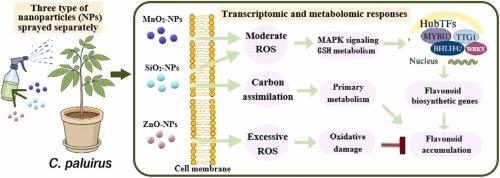Metal and non-metal nanoparticles differentially regulate flavonoid accumulation in Cyclocarya paliurus: A multi-omics analysis
IF 6.2
1区 农林科学
Q1 AGRICULTURAL ENGINEERING
引用次数: 0
Abstract
Nanotechnology offers emerging tools for elevating metabolites levels in agricultural and medicinal crops, yet its regulatory effects on woody species remains underexplored. Cyclocarya paliurus, a precious tree species with flavonoid-linked antioxidant and hypoglycemic properties, was foliar-applied with nanoparticles (NPs) of ZnO, MnO2, and SiO2 to investigate their elicitation potential under field-simulated conditions. Compared with the control, applications of MnO2- and SiO2-NPs markedly increased total flavonoid content (TFC) in C. paliurus leaves by 21.26–49.99 %, and enhanced per-plant flavonoid accumulation by 40.70–50.06 %. Conversely, applications of high-dose ZnO-NPs induced oxidative imbalance, resulting in a 30.25 % and 43.84 % decline in TFC and flavonoid accumulation respectively. Multi-omics profiling revealed that both MnO2- NPs and SiO2-NPs activated ROS-dependent pathways involving MAPK and glutathione signaling, while SiO₂-NPs may also promote flavonoid biosynthesis via enhancing carbon fixation and primary metabolism. The MYB-bHLH-WD40 complex (including MYB113, bHLH42, and TTG1) was identified as a central regulatory node, ranking among the top 10 contributors in O2PLS analysis and exhibiting strong correlations (cor > 0.95) with flavonoid metabolites. Collectively, we propose a model wherein ROS signaling induced by NPs interacts with transcriptional networks to modulate flavonoid accumulation. This work provides a nano-enabled strategy to boost health-promoting compounds in the woody plants.

金属和非金属纳米颗粒对黄酮类化合物积累的差异调控:多组学分析
纳米技术为提高农业和药用作物的代谢物水平提供了新兴工具,但其对木本物种的调控作用仍未得到充分探索。摘要以黄酮类化合物抗氧化和降糖为研究对象,在叶片上施用氧化锌、二氧化锰和二氧化硅纳米颗粒(NPs),研究其在野外模拟条件下的激发电位。与对照相比,施用MnO2-和SiO2-NPs可显著提高黄颡鱼叶片总黄酮含量(TFC) 21.26 ~ 49.99 %,提高单株黄酮积累量40.70 ~ 50.06 %。相反,施用高剂量ZnO-NPs诱导氧化失衡,导致TFC和类黄酮积累分别下降30.25 %和43.84 %。多组学分析显示,MnO2- NPs和SiO2-NPs都激活了包括MAPK和谷胱甘肽信号转导在内的ros依赖通路,而SiO2-NPs也可能通过增强碳固定和初级代谢来促进类黄酮的生物合成。MYB-bHLH-WD40复合体(包括MYB113、bHLH42和TTG1)被确定为中心调控节点,在O2PLS分析中排名前10位,与类黄酮代谢产物表现出强相关性(cor > 0.95)。总的来说,我们提出了一个模型,其中由NPs诱导的ROS信号与转录网络相互作用来调节类黄酮的积累。这项工作提供了一种纳米策略来促进木本植物中促进健康的化合物。
本文章由计算机程序翻译,如有差异,请以英文原文为准。
求助全文
约1分钟内获得全文
求助全文
来源期刊

Industrial Crops and Products
农林科学-农业工程
CiteScore
9.50
自引率
8.50%
发文量
1518
审稿时长
43 days
期刊介绍:
Industrial Crops and Products is an International Journal publishing academic and industrial research on industrial (defined as non-food/non-feed) crops and products. Papers concern both crop-oriented and bio-based materials from crops-oriented research, and should be of interest to an international audience, hypothesis driven, and where comparisons are made statistics performed.
 求助内容:
求助内容: 应助结果提醒方式:
应助结果提醒方式:


